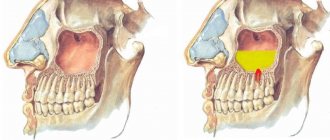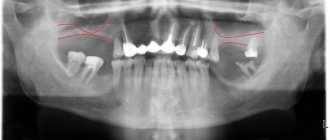Many parents are still confident that baby teeth do not need the same thorough treatment as permanent teeth - after all, they will still break down and fall out. Unfortunately, this point of view is erroneous and often leads to serious health problems in children. Children, like adults, can also develop various diseases of the teeth and gums, and they must be treated in a timely manner. If you do not treat children's teeth, over time problems with the bite and dental system will arise, and in some cases the general health of the body may be at risk. This is especially true if infants are teething.
Content:
- After caries closure
- After root canal treatment
- After extraction
- After implantation
- After sinus lift
The problems that dentists have to solve can be serious or not so serious.
But any medical intervention must be carried out in accordance with established norms and rules. Only then will the likelihood of complications develop to a minimum. One of the most common unpleasant symptoms after dental treatment is fever. Many patients are confused and do not know what to do when it increases. After all, it is not always clear whether a fever is related to a recent dental course.
Dentists insist that if the temperature rises after dental treatment, patients immediately consult a doctor. Timely receipt of qualified medical care is the most reasonable decision in such situations.
Is the temperature normal or not?
Many patients wonder whether the temperature can increase after tooth extraction? Dentists answer this question positively. Extraction, even despite the quality of modern dental services, causes physiological and psychological stress. After tooth extraction, a temperature of up to 37 °C is considered normal. If the removal was difficult, other signs may be present: swelling of the soft tissues, redness of the gums and slight bleeding. The patient also often feels dizzy and weak. These symptoms disappear within the first day.
Depending on how long the temperature lasts after tooth extraction, we can talk about the risks of pathological processes. A high rate or persistence of temperature for more than 2 days is a sign of an inflammatory process. Accompanying symptoms: the general condition may deteriorate greatly, the gums are very painful, and pus begins to ooze from the socket.
Because immediately after tooth extraction, the hole remains unprotected, and infection can penetrate inside, causing inflammation and other pathological processes. If your condition worsens on the second day after visiting the dentist, you must immediately visit the clinic to avoid further development of the disease.
After caries closure
Sooner or later, everyone faces the need to close carious cavities. With caries, the pathological process does not extend beyond the hard tissues. If your health condition worsens after filling, you can assume:
- development of a viral, infectious or bacterial infection not related to a recent medical intervention;
- the addition of complications such as pulpitis, abscess, phlegmon.
Determining the root cause of the problem is actually not difficult. If the sealed molar looks healthy and does not hurt, the gums are not swollen or swollen, and the mucous membranes are not ulcerated, it means that with a 90-95% probability the temperature has not increased due to treatment at the dental center. It’s just that at the time of therapy the patient was already sick, but the symptoms of the disease had not yet manifested themselves or were barely noticeable.
The stress experienced during the operation of the drilling machine can create conditions for the rapid spread of infection. Then, upon coming home, a person will see frightening numbers on the thermometer.
After root canal treatment
Endodontic therapy involves complex manipulations. After it, your health may actually worsen. How long the painful condition will last depends on the degree of damage to the tissues of the oral cavity and the extent of the abnormal process.
Pulpitis itself rarely provokes fever, but its complications - periodontitis, cysts, periostitis, any purulent processes - quite often. Hyperthermia occurs in response to an inflammatory response. In parallel, the following may be observed:
- swollen lymph nodes;
- strong pain;
- swelling of the cheek;
- gum “bump”;
- discharge of purulent masses.
If after endodontic intervention the elevated temperature lasts longer than two to three days, you should definitely consult a doctor. This must be done immediately if the tooth hurts or pus flows.
What can a dentist do?
Even in case of complications after tooth extraction, a qualified dentist can provide assistance and provide effective treatment. Depending on the causes and existing consequences, the specialist will prescribe the necessary treatment or carry out the necessary procedures.
The main goal of the dentist is to clean the hole from necrotic tissue, eliminate infection and relieve inflammation. After stabilization of the patient’s condition, therapeutic treatment aimed at tissue restoration begins. Rehabilitation will be difficult and take a lot of time.
To prevent complications after tooth extraction, dentists recommend following all wound care tips, taking prescribed medications for complex extractions, and monitoring the temperature. If you consult a dentist at the first sign, treatment will proceed quickly and serious consequences will be avoided. When planning a tooth extraction, it is necessary to properly prepare for the procedure by undergoing preliminary diagnostics and eliminating inflammatory processes in the body.
After extraction
Extracting the root unit is a surgical procedure. It is associated with a violation of the integrity of oral tissues. It is not surprising that the human body reacts so sharply to the treatment.
Normally, after removal, the thermometer can show up to 38.5°C for no longer than three days. It is not advisable to take antipyretics - such tactics can change the course of recovery reactions. However, in some cases, doctors prescribe anti-inflammatory drugs to speed up regeneration processes. Some of them not only stop inflammation, but also normalize body temperature. If the doctor told you to use pills, you should do so. Any amateur activity is prohibited here.
In difficult clinical situations, antibiotics are prescribed after extraction. There are patients who are critical of such prescriptions. It seems to them that antibacterial drugs lower the immune system and their use after an ordinary removal of a unit is unjustified.
This attitude towards antibiotics is wrong. They help damaged tissues heal faster and eliminate the development of postoperative complications. Dentists never prescribe them just like that. Therefore, if a specialist issues a prescription after extraction, you need to take its prescription seriously.
Most often, an elevated temperature is recorded after removal:
- "eight";
- incisors, fangs, molars, if the operation was preceded by an advanced purulent process;
- several units at once.
Consequences of pulpitis
Consequences of pulpitis
The biggest mistake that some patients make when experiencing toothaches is the desire to endure them, drowning them out with painkillers. This often leads to the development of dangerous complications of pulpitis, acute or chronic periodontitis. In addition to unbearable throbbing pain, high body temperature and complete loss of ability to work are added. Seeing a doctor at this stage of the disease is accompanied by increased psychological and physical discomfort for the patient, and after treating the tooth cavity, where the pulp was previously located, purulent contents with an unpleasant odor come out.
When periodontitis that arises against the background of pulpitis enters the chronic stage, fistulas with purulent contents form on the gums. This stage of the disease is considered the most dangerous to human health. Patients who have passed this stage remember for the rest of their lives the terrible picture of hanging “pus pockets” from their newly extracted teeth. Whenever at this moment it becomes clear that sometimes it is better to prevent than to treat. However, complications of pulpitis can lead not only to tooth loss, but sometimes serious diseases develop that threaten the patient’s life: phlegmon, abscess and sepsis.
Phlegmon leads to the fact that the patient’s general well-being sharply deteriorates, body temperature rises to a critical level, the shape of the face is distorted, and in addition to pain, a feeling of fullness in the jaw occurs. Sepsis is a blood poisoning and the most dangerous complication of untreated pulpitis, in which death cannot be ruled out.
Are you still wondering whether to see a dentist?
After implantation
Implantation is an operation to implant an artificial titanium root into the bone tissue of the jaw , on top of which, after regeneration is completed, an abutment and crown are fixed. Such treatment is always difficult and traumatic. It is performed under local anesthesia and requires long-term rehabilitation.
Meanwhile, it is implants that make it possible to restore the integrity of the dentition without damaging healthy units. Their installation is not associated with grinding down the “neighbors” or root canal treatment. Implantation is indicated if the tooth is completely destroyed, and even its roots are unsuitable for prosthetics.
Dentists always warn that after installing a titanium base, an elevated temperature may persist for three to five days, and this is normal. Fever indicates the active occurrence of regenerative processes. To avoid possible complications, the patient must take medications prescribed by the implantologist strictly according to schedule.
It is important to understand that the line between normality and pathology is very thin. Fever after implantation can also be a dangerous signal. So, sometimes it indicates rejection of an artificial structure. Then the person feels severe pain in the area of the surgical intervention, observes swollen gums from which pus is released, and constantly feels an unpleasant taste in the mouth. Soon the implant becomes mobile, which indicates its active rejection.
In this case, there is no point in hoping that the situation will normalize on its own. You need to go to the doctor immediately. The sooner the patient visits the doctor who implanted the implant, the higher the chances of stopping further progression of inflammation. If time is lost, the titanium base will most likely have to be removed.
After sinus lift
Speaking about the reasons for the increase in temperature after dental therapy, it is necessary to mention bone grafting. Such an operation sometimes precedes procedures to restore the integrity of the row. The need for it arises if the patient has been walking for a long time with a toothless smile. Then the gums in the areas of damaged teeth begin to “sag.”
This effect is due to atrophy of bone tissue and is due to the fact that certain areas of the jaw do not take part in the process of chewing food. Then, before installing the implant, the doctor performs bone grafting. During this procedure, the gum level is raised by placing a special collagen membrane under the soft tissue. After this, they wait about three to four months until the introduced artificial material takes root. Only after this they proceed to implantation.
The human body does not always react calmly to an established bone sample. In the first days after plastic surgery, ailments often appear. There's nothing wrong with that. The main thing is that the patient takes the medications prescribed by the doctor.
Summarize. If you experience a high fever after dental treatment, do not worry. This is usually a normal reaction to complex interventions. But be careful. The fever should not persist for a long time. You shouldn't guess what's going on in your mouth. If you have the slightest doubt, visit your doctor again. He will tell you how to normalize the situation.
Acute pulpitis
- Focal
Pulpitis, in which inflammation affects only part of the pulp; manifested by severe paroxysmal pain every 5-7 hours for 10-15 minutes; the patient can pinpoint the tooth that is the source of the pain.
- Diffuse
Pulpitis, in which inflammation covers the entire pulp; attacks of pain last up to one hour, and sometimes longer; the pain radiates to neighboring teeth and gradually covers the entire jaw and head.
- Purulent
With this form of the disease, irreversible dissolution of the pulp tissue occurs, the pain becomes unbearable; A characteristic sign of purulent pulpitis is dulling of pain when exposed to cold, so the patient often spends time waiting for a doctor with a bottle of cold water applied to his cheek.
- Traumatic
Occurs after trauma to the jaw, after treatment or fracture of a tooth, when the pulp is exposed and causes acute pain when breathing, touching and at rest.










